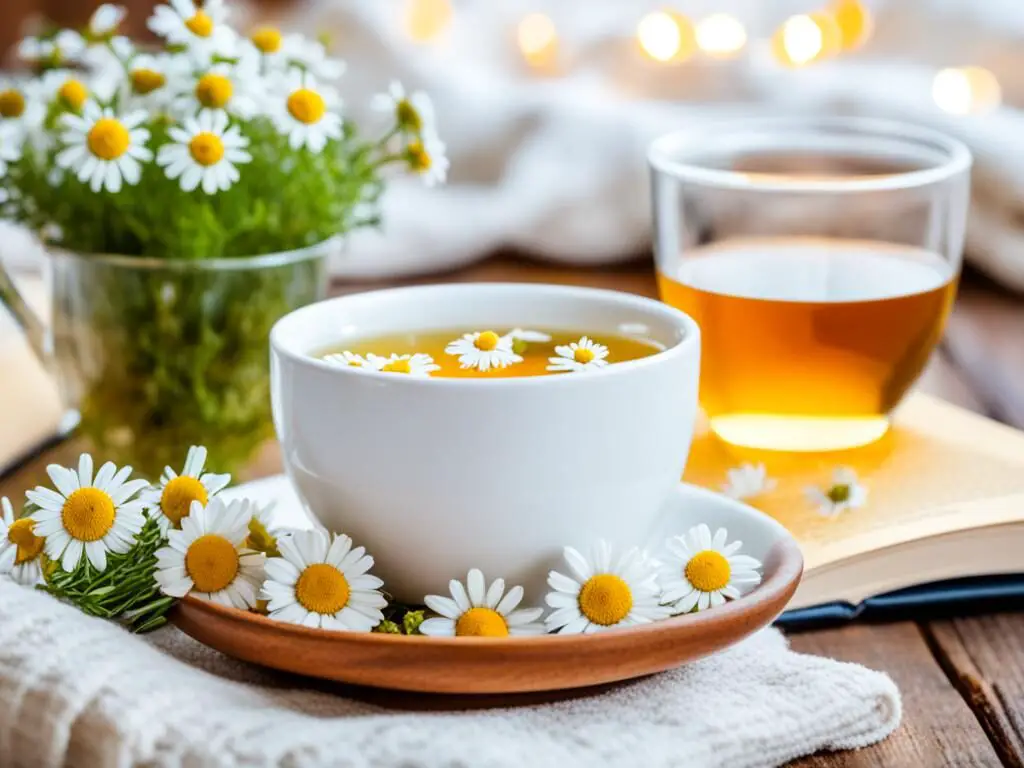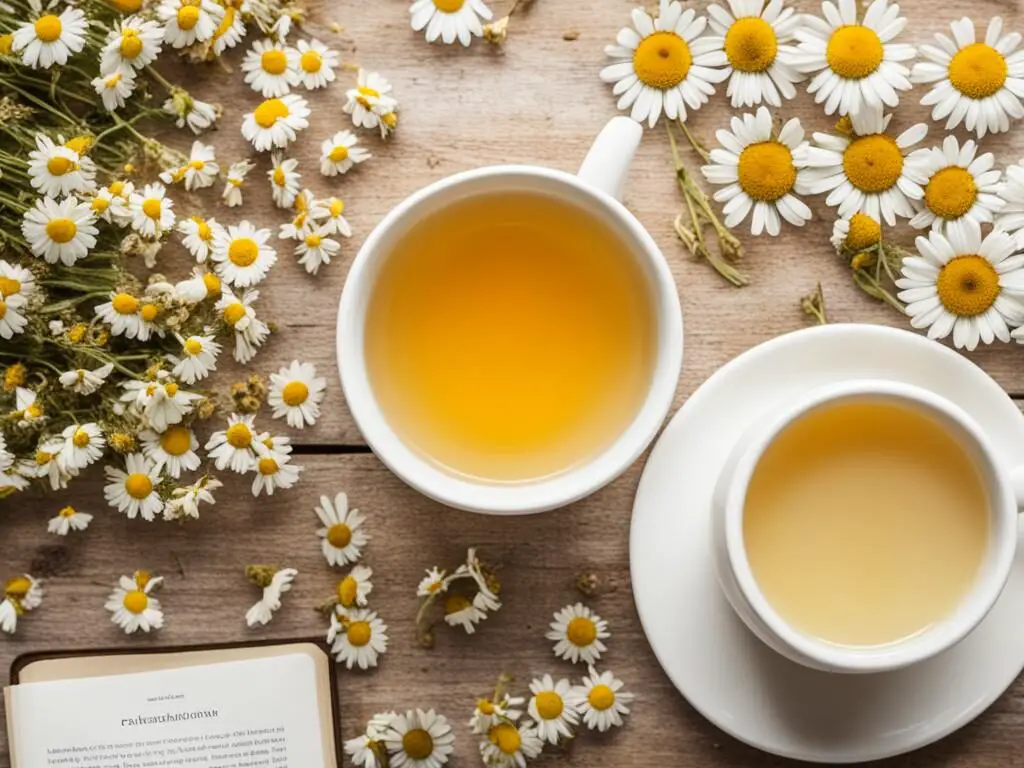If you’re struggling with restless nights and are searching for a natural remedy to help you catch some zzz’s, look no further. Sleepy time chamomile tea is a soothing and aromatic drink that has been used for centuries to promote better sleep.
Whether you find it difficult to fall asleep or stay asleep throughout the night, incorporating chamomile tea into your bedtime routine may be just what you need. This herbal tea is known for its calming properties, making it the perfect ally for a peaceful slumber.
Ready to discover how to make your own sleepy time chamomile tea? Keep reading to uncover a simple recipe to brew your own cup of relaxation and set the stage for a restful night’s rest.

Key Takeaways:
- Sleepy time chamomile tea can significantly improve sleep quality.
- Chamomile tea has been used for centuries as a natural remedy for sleeplessness.
- The calming properties of chamomile tea can help reduce anxiety and promote relaxation.
- By incorporating chamomile tea into your bedtime routine, you
- can create a soothing ritual that signals your body and mind to prepare for sleep.
- Stay tuned for the step-by-step guide on how to make your own sleepy time chamomile tea.
Understanding the benefits of chamomile tea for sleep
Before we dive into the recipe, let’s explore why chamomile tea is believed to promote better sleep quality. Chamomile tea is an herbal tea that has long been used as a natural sleep remedy. Its calming properties may help reduce anxiety and relax the mind, making it easier to fall asleep. Research suggests that chamomile tea may also have sedative effects, making it an effective sleep aid.
Chamomile tea is known for its mild and soothing taste, making it a delightful choice for bedtime. It is made from the dried flowers of the chamomile plant and has a long history of use as a traditional medicine. Chamomile tea contains several compounds that are believed to contribute to its sleep-inducing effects, including apigenin, a flavonoid that may bind to specific receptors in the brain, promoting relaxation and reducing insomnia.
Studies have shown that regularly consuming chamomile tea may lead to improved sleep quality and decreased sleep latency (the time it takes to fall asleep). This herbal tea is thought to enhance the overall sleep experience, resulting in a more restful and rejuvenating night’s rest.
“Chamomile tea is a natural sleep aid that can help calm your mind and promote a restful sleep.”
If you struggle with sleep quality or are looking for a natural remedy to help you unwind before bed, chamomile tea may be just what you need. Its gentle aroma and soothing taste make it a perfect addition to your bedtime routine.
Stay tuned as we move on to the next section to discover the ingredients you’ll need to make a cup of delicious sleepy time chamomile tea.
The ingredients you’ll need to make sleepy time chamomile tea
To make sleepy time chamomile tea, you’ll need a few simple ingredients:
- Chamomile tea: The star of the show. Choose between loose chamomile flowers or pre-packaged chamomile tea bags, depending on your preference.
- Tea infuser or strainer: If you opt for loose chamomile flowers, you’ll need a tea infuser or a strainer to steep the tea and ensure a smooth infusion.
- Hot water: Essential for steeping the chamomile tea and extracting its soothing properties. Make sure the water is hot but not boiling.
- Sweetener (optional): If you prefer your tea slightly sweetened, have your favorite sweetener on hand. Honey or a touch of stevia are great natural options.
Once you have these ingredients ready, you’re all set to brew yourself a cup of comforting sleepy time chamomile tea. Now, let’s move on to the step-by-step guide for making this relaxing bedtime beverage.
| Ingredient | Quantity |
|---|---|
| Chamomile tea | 1 tea bag or 1 teaspoon of loose flowers |
| Tea infuser or strainer | 1 |
| Hot water | 1 cup |
| Sweetener (optional) | To taste |

Step-by-step guide to brewing sleepy time chamomile tea
Now that you have all the necessary ingredients, let’s dive into the process of making sleepy time chamomile tea.
- Boil water in a kettle or a saucepan. You’ll need about 1 cup of hot water for each serving of chamomile tea.
- If you’re using loose chamomile flowers, prepare your tea infuser or strainer. Place about 1 tablespoon of chamomile flowers into the infuser or strainer.
- If you prefer using pre-packaged chamomile tea bags, you can skip the previous step.
- Pour the hot water into a teacup or a mug.
- Place the chamomile tea infuser or the tea bag into the hot water.
- Let the chamomile tea steep for about 5-10 minutes. This will allow the flavors and calming properties of chamomile to infuse into the hot water.
- While the tea is steeping, prepare your desired sweetener, such as honey or sugar, if you prefer a sweeter taste.
- Once the steeping time is up, remove the chamomile tea infuser or tea bag from the cup.
- Add your desired amount of sweetener to the tea, if desired. Stir well to dissolve the sweetener.
- Your sleepy time chamomile tea is now ready to drink! Find a cozy spot, take a deep breath, and enjoy the soothing aroma and taste of this herbal sleep aid.
Remember to drink your chamomile tea at bedtime for optimal relaxation and sleep-promoting effects.
Quote:
“A cup of chamomile tea is like a tranquil bedtime ritual that helps me unwind and prepare for a restful night’s sleep.” – Jessica, Tea Lover

Conclusion
Sleep is essential for our overall well-being, and incorporating natural sleep remedies can greatly improve sleep quality. One such remedy is chamomile tea, which offers a range of benefits that promote relaxation and better sleep.
By following a simple recipe and incorporating a cup of sleepy time chamomile tea into your bedtime routine, you can create a relaxing ritual that prepares your mind and body for a peaceful night’s rest. Chamomile tea is known for its calming properties and may help reduce anxiety, making it easier to fall asleep. In addition, chamomile tea may have sedative effects, acting as an effective sleep aid.
So, why not brew yourself a cup of this calming tea and experience the natural sleep remedies and chamomile tea benefits firsthand? Incorporating chamomile tea into your bedtime routine may just be the relaxing solution you need to improve your sleep quality and wake up feeling refreshed and rejuvenated.
FAQ
How does chamomile tea improve sleep quality?
Chamomile tea is believed to promote better sleep quality due to its calming properties. It can help reduce anxiety and relax the mind, making it easier to fall asleep. Research suggests that chamomile tea may also have sedative effects, making it an effective natural sleep aid.
What ingredients do I need to make sleepy time chamomile tea?
To make sleepy time chamomile tea, you’ll need chamomile tea, either loose flowers or tea bags. If you opt for loose flowers, you will also need a tea infuser or a strainer. Additionally, make sure you have hot water and your favorite sweetener on hand, if desired.
How do I make sleepy time chamomile tea?
Here is a step-by-step guide to brewing sleepy time chamomile tea:
- Boil water in a kettle or on the stovetop.
- If using loose chamomile flowers, place them in a tea infuser or strainer.
- Pour hot water over the chamomile tea and let it steep for about 5 minutes.
- Remove the tea infuser or strainer.
- Add sweetener, if desired.
- Sip and enjoy your calming bedtime tea!
Can chamomile tea help me fall asleep?
Chamomile tea’s calming properties may help you sleep as well as relax your mind and prepare your body for sleep, making it easier to fall asleep. It can be a gentle aid in your bedtime routine.
How often should I drink chamomile tea to help me sleep?
It’s generally recommended to drink a cup of chamomile tea about 30-60 minutes before bedtime to promote sleep. You can drink a cup every night as part of your regular bedtime routine. Chamomile is safe to consume regularly, so feel free to drink a cup any evening you need extra relaxation and sleep support.
What are some tips for making chamomile tea taste better?
To enhance the flavor of your chamomile tea, you can add lemon, cinnamon, vanilla extract, mint, or a natural sweetener like honey or maple syrup. Brewing the tea for a shorter time, about 5 minutes, can also help prevent bitter flavors. Drinking it from your favorite teacup while warm can make sipping chamomile tea more soothing.
Is chamomile tea safe for children to drink?
Chamomile tea is typically safe for children over 1 year old to drink, but check with your pediatrician. Make sure to brew weak chamomile tea with just 1 bag or 1/2 teaspoon dried flowers per cup of hot water. Serve it warm, not hot, and limit your child to 1 small cup per day as part of the bedtime routine. Supervise young children while drinking.
How does drinking chamomile tea promote sleep?
Chamomile tea contains apigenin, a natural compound that binds to specific receptors in the brain that promote relaxation and sleepiness. Sipping its warm, soothing liquid can help calm your mind and body, making it easier to fall asleep naturally. The ritual of drinking tea before bed also signals your brain that it’s time to relax.
Does chamomile tea work right away to make you sleepy?
Chamomile tea takes about 30-45 minutes to kick in. Sip a cup 1 hour before your desired bedtime so the chamomile has time to enter your system and exert its relaxing effects. It’s not an instant sleep aid but rather gently eases your transition into quality sleep when used regularly.
Are there any other natural sleep remedies I can try?
Yes, there are several other natural sleep remedies you can try alongside chamomile tea. These include establishing a regular bedtime routine, creating a comfortable sleep environment, avoiding caffeine and electronic devices before bed, practicing relaxation techniques like deep breathing or meditation, and getting regular exercise.